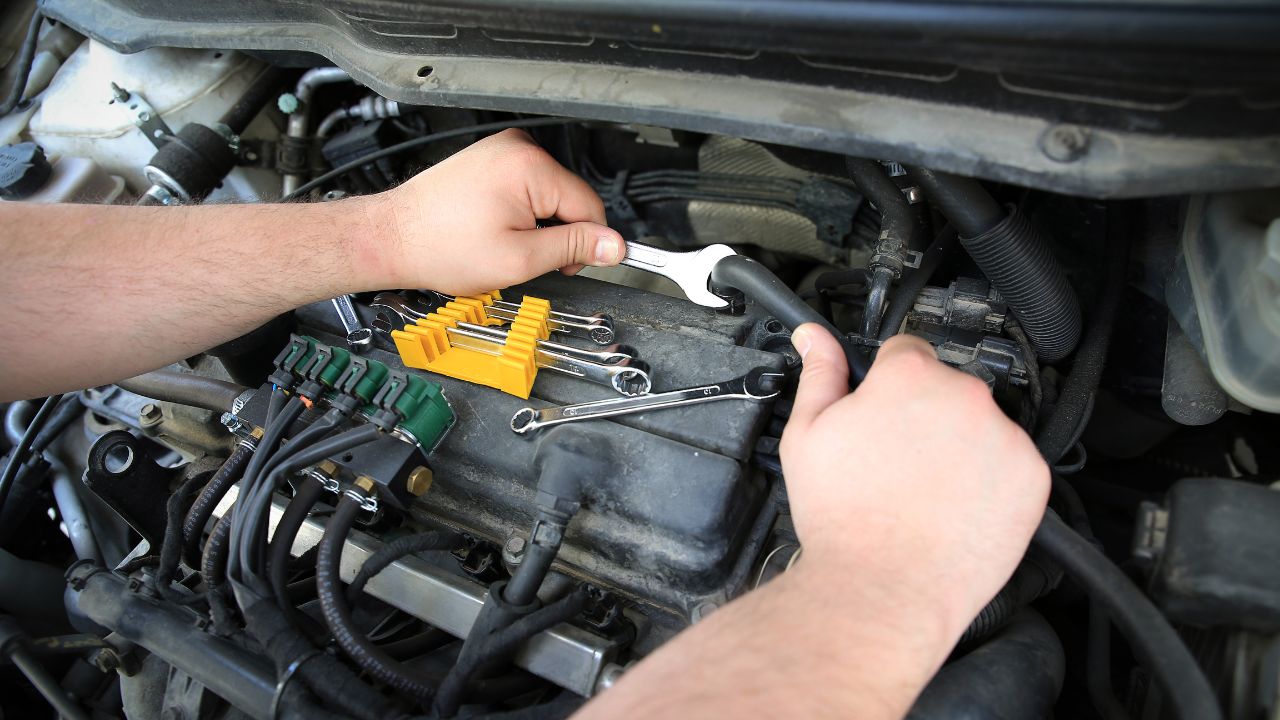
ASE certification can be a prerequisite to becoming an auto mechanic. The ASE certificate is a mark of professionalism. It requires two years' on-the-job training as well as a test. You must retake the test every five years to maintain the certification. Here are the steps to become an ASE certified mechanic. You can read on to find out more about ASE certification.
ASE certification is the minimum standard for excellence in auto mechanics
You may have seen a sign advertising an "ASE certified mechanic" in your local shop. While anyone can hold a sign declaring themselves an auto mechanic, it is important that you keep in mind that the term "automatician" isn't a fixed term. This position does not require a minimum education, so it is easy to become confused about what qualifications a mechanic must have.

It requires two years of on-the-job training
You can become an ASE certified mechanic by passing the required tests. The tests are not free. Applicants should have sufficient funds to cover them. The tests must be administered twice annually and applicants should wait at the least six months to take them again. ASE test are developed by a national panel including engineers, aftermarket parts manufacturers, and automakers. Although the questions and answers can be easily faked it is important that applicants have a thorough knowledge of automotive repair. Additionally, the exam must not be repeated for five years. It is recommended to take the exam at minimum once.
It requires a test
To become an ASE mechanic certified, you must pass a certification test. The test is administered by the National Institute for Automotive Service Excellence, or ASE. Study materials and a sample test are provided by the National Institute for Automotive Service Excellence (ASE). An ASE testing center can also offer the opportunity to take the test. The test center has several convenient locations where you can take your test. To become an ASE certified mechanic, you must take a test in order to become a Master Technician.
It is a symbol to show professionalism
The ASE certified mechanic's seal of excellence can be seen on many businesses' websites. This is a sign these businesses use only the finest mechanics, which ensures the highest quality repairs. ASE certified mechanics have certificates and shoulder insignia displayed in customer service areas. ASE has also recognized the best auto repair businesses with 75 percent or more certified technicians. Blue Seal of Excellence is a national recognition of 1,500 businesses that offer superior service. Ask your family and friends for recommendations and read reviews from customers to help you choose the right auto repair shop. Also, don't select a shop based on its proximity to your home, and don't make any transportation arrangements until you are certain of your appointment time.

It is difficult to obtain this level of success.
An ASE certified mechanic can help your company stand out. Although mechanics don't have to maintain their certification in most states, being ASE certified can help you stand out among the rest and provide peace of mind for your customers. This certification is worth up to $24,000 per annum and comes with a free trial period. Many certified mechanics are able to use their education credits toward their degree programs.
FAQ
Do I need to have a degree to work as an automotive mechanic? Can I study part time?
Although it's not mandatory, a degree can help. Employers will prefer candidates who have completed a degree. It shows that your efforts have been put in and you have succeeded.
But, this doesn't mean you have to stop working while studying. Many universities permit students to take courses during the summer holidays, and then finish their studies in the fall. Others allow students to study part-time all year.
Is it hard being a mechanic apprentice
Although it's not an easy task, you will learn quickly and have many opportunities to advance.
You need to have patience and perseverance. It is also important to know how you can fix vehicles, trucks, or motorcycles.
Customers and loved ones can place a lot of pressure on you. You shouldn't feel pressured to make decisions that you don't like.
This is a career that you might enjoy if you are passionate about fixing cars. This is a job that allows you to earn a decent income and grow your business.
But you may prefer another path. This is where you might be interested in becoming a technician.
This could involve using your technical knowledge to support other employees. This could be a way to help technicians with their problems or to teach them new techniques.
Another option is to become an advisor in service. Here, you'll provide advice and assistance to customers when they bring their cars to a garage.
Your choice is based on what you choose to do. There are many options, so you can choose the one that suits you best.
What length is an automotive mechanic apprenticeship?
It takes three years to complete an apprenticeship as an automotive mechanic. It includes two years of school and two years as an apprentice. The first year of training is spent in the trade. This includes theory and practical skills as well as safety procedures. You'll also learn how tools can be used safely and efficiently during this year. After completing the first year, you'll then spend another year on-the-job training where you'll gain experience in different areas of the trade. You will have the opportunity for formal training during these years.
The final year is dedicated to earning certifications and qualifications in the field. These include NVQs or National Vocational Qualifications. These are earned after passing exams that cover specific topics in the industry. There are also HNCs (Higher National Certificates), which cover general subjects like management, business administration, customer service, and more. City & Guilds certificates offer qualifications in certain trades.
What is the difference between an automotive technician and a mechanic?
These two jobs are very similar but not identical. Both a mechanic and an automotive technician can repair cars.
A mechanic should be able to do simple tasks quickly and have good manual dexterity. A mechanic must be able diagnose and fix problems quickly and accurately.
An automotive technician must be more technically proficient than a mechanic. They should be able read blueprints and use tools like drills and wrenches.
They must also be able perform complex procedures safely. They should also be familiarized with the different types of engines as well as electrical systems.
They must also be able to understand how various parts interact with each other.
As a result, mechanics typically make less than technicians. But there are many opportunities for both jobs.
What length is an automotive course?
An automotive course lasts for three years.
The first year is dedicated to theory and learning about cars. The second year is dedicated towards practical training. This includes learning how to drive, fix engine problems, and doing other maintenance jobs around your car. You will spend the final year working in a local garage to gain real-world experience.
Is it worth learning to be a mechanic?
The answer depends on what you are looking for in life. If money is your goal, then you can answer "yes". But if you are searching for meaning and purpose, then you should not answer this question.
You don't need to be a mechanic if you don't know how. It's not going to make you rich. It will not make you famous. You won't be famous.
You'd have to spend years learning how things work. Also, you would need to hire someone else to fix it if it broke down. It's the reason most people don't bother. They find something else to do.
You can make a lot of money if you are looking to do well. You can't live a meaningful existence if your goal is to make a living in the mechanic's business.
What qualifications do you need to be a mechanic?
You will need to pass several exams in order to become a mechanic. These exams include:
-
A general knowledge test
-
A practical exam
-
An apprenticeship test
These tests are designed for you to understand the basic concepts and principles of mechanics before your start as a technician.
These tests will allow you to be a mechanic once you have passed them. You'll still need an apprenticeship. This will require you to learn the trade.
To be able to repair vehicles, you'll need classes or workshops. Experienced mechanics will also be required.
A mechanic must be highly focused and attentive to detail in order to succeed. It is essential to pay attention to all aspects of vehicle repairs.
To be a successful mechanic, you will need patience and perseverance. This may not be the career path that you want if you aren't able to follow directions.
If you enjoy cars and fixing them, this job could be a good fit for you.
Statistics
- According to the BLS, the median annual salary for automotive service technicians and mechanics in the United States was $44,050 in May 2020. (uti.edu)
- There were 749,900 jobs available for automotive service technicians and mechanics in 2016, which is expected to grow by six percent through 2026. (jobhero.com)
- 52% of Mechanics in the United States think their salaries are enough for the cost of living in their area. (indeed.com)
External Links
How To
How to properly diagnose your vehicle for repair
First, look at the symptoms of your car to determine if it needs repair. Follow these steps to properly diagnose your vehicle.
-
Check engine lights. Check the dashboard light indicators such as the engine light indicator, the oil pressure gauge, the battery light indicator, the coolant temperature gauge, and the RPM gauge. It could indicate that your vehicle is having problems.
-
Inspect the tire treads. Tires with worn treads could cause problems when handling or braking. You should inspect the treads on your wheel. They should be clean and smooth. You can do this by taking off the wheels. To check the condition of your treads, use a flashlight.
-
Monitor the level and consistency of your brake fluid. It is important to keep track of how much brake fluid you have in your car. This helps ensure that your brakes operate properly. If the brake fluid level is low, your brakes might fail when you apply pressure to them.
-
Check the suspension system. It is common for vehicles to have a suspension system which absorbs shocks or vibrations. It provides better control and allows smoother acceleration and deceleration. If your vehicle has a suspension problem, it might feel wobbly or shake uncontrollably. Try putting some weight on your front or rear axle to determine if you have a suspension problem.
-
Take a look at the steering column. Steering columns connect the steering wheels to other parts of the vehicle. Accidents often damage steering columns. You should replace the steering column if it is loose or weak.
-
Pay attention to the exhaust pipe. The exhaust pipes transport gases from the combustion chamber to outside. You can let harmful fumes into your home if your exhaust pipes crack or leak. Additionally, your tailpipe should be fixed immediately if it is bent.
-
Take a look under your hood. Look underneath your hood to see if anything looks strange. Fluids could be leaking from your engine. In addition, if you notice an unusual smell coming from your engine compartment, you should contact a professional technician.
-
Make sure to check the air filter. The air filter in your vehicle collects dirt and dust from the environment. Vehicles that have a dirty air filter will not run well. Replace your air filter regularly.
-
Make sure you check the fan belt. The fan belt is the link between the engine and the transmission. If it breaks, the engine won't turn over. It's easy to replace the belt. You only need a screwdriver or pliers to replace your belt.
-
You should inspect the radiator and hoses. The radiator hose carries water from the radiator to the engine. It can become cracked or damaged and leak hot liquid onto your engine. To repair the leaky hose, all you need is a pair if needle-nosepliers.
-
Check the windshield wipers. Windshield wipers use electricity for snow and rain removal. If they stop working, streaks could be left on your glass. The solution is to change the washer fluid.
-
Check the battery cables. Your car's electrical system is powered by batteries. Always disconnect the negative wire before you replace batteries. Failure to do so can damage your alternator.
-
Pay attention to your headlights. The headlights provide illumination for the road ahead. Poor visibility can result if the headlights don't function properly. Inspect the bulbs for signs of burnt out.
-
Make sure you have your lights on. If you approach other drivers at night, lights will warn them. One that doesn't work could cause you to be distracted, and possibly lead to an injury.
-
Check your brakes. Before you have a collision, brakes slow down your car. If your brakes aren't working properly, you may lose control and crash into other cars.
-
Change the oil. Your engine will stay lubricated by the oil. It helps prevent metal parts from wearing out too quickly. It is recommended that you change your oil at least once per month.